Bees are in big trouble. The good news is that virtually all ecologically literate North Americans will tell you that. The bad news is they’re worried about the wrong bees — honey bees.
Honey bees don’t belong in North America; they’re domesticated aliens from Europe. “Worrying about their extinction is like worrying about the extinction of cattle,” declares native-bee activist and acclaimed wildlife photographer Clay Bolt.
But North America could lose many of its roughly 4,000 native bee species. For example, applying criteria of the International Union for Conservation of Nature, the Xerces Society for Invertebrate Conservation reports that of the 46 indigenous bumble bee species in the U.S. and Canada 28 percent are at some risk of extinction.
While bumble bees aren’t well understood, they’re well loved. They are so good-natured that getting a female to sting you (males can’t) is a major undertaking. Proceed carefully and you can even stroke her Teddy-bear-like fur. That fur, along with ability to regulate body temperature, allows bumble bees to be out and about on cold mornings long before honey bees rev up. Bumble bees have even been seen 1,055 miles north of the Arctic Circle.
In late winter while most insects are dormant or unhatched, queen bumble bees, the biggest bees you’ll see all year, start searching for nest sites. The queen’s flight is not wild and erratic as Rimsky-Korsakov’s operatic score implies, but slow, low and deliberate. Frequently she’ll select an abandoned rodent hole, camouflage it with leaves, moss or grass, then fashion a wax pot and fill it with honey. Finally, she’ll knead pollen into “bee bread.” The honey will sustain her while she’s brooding the year’s new colony. The bee bread will nourish the larvae.
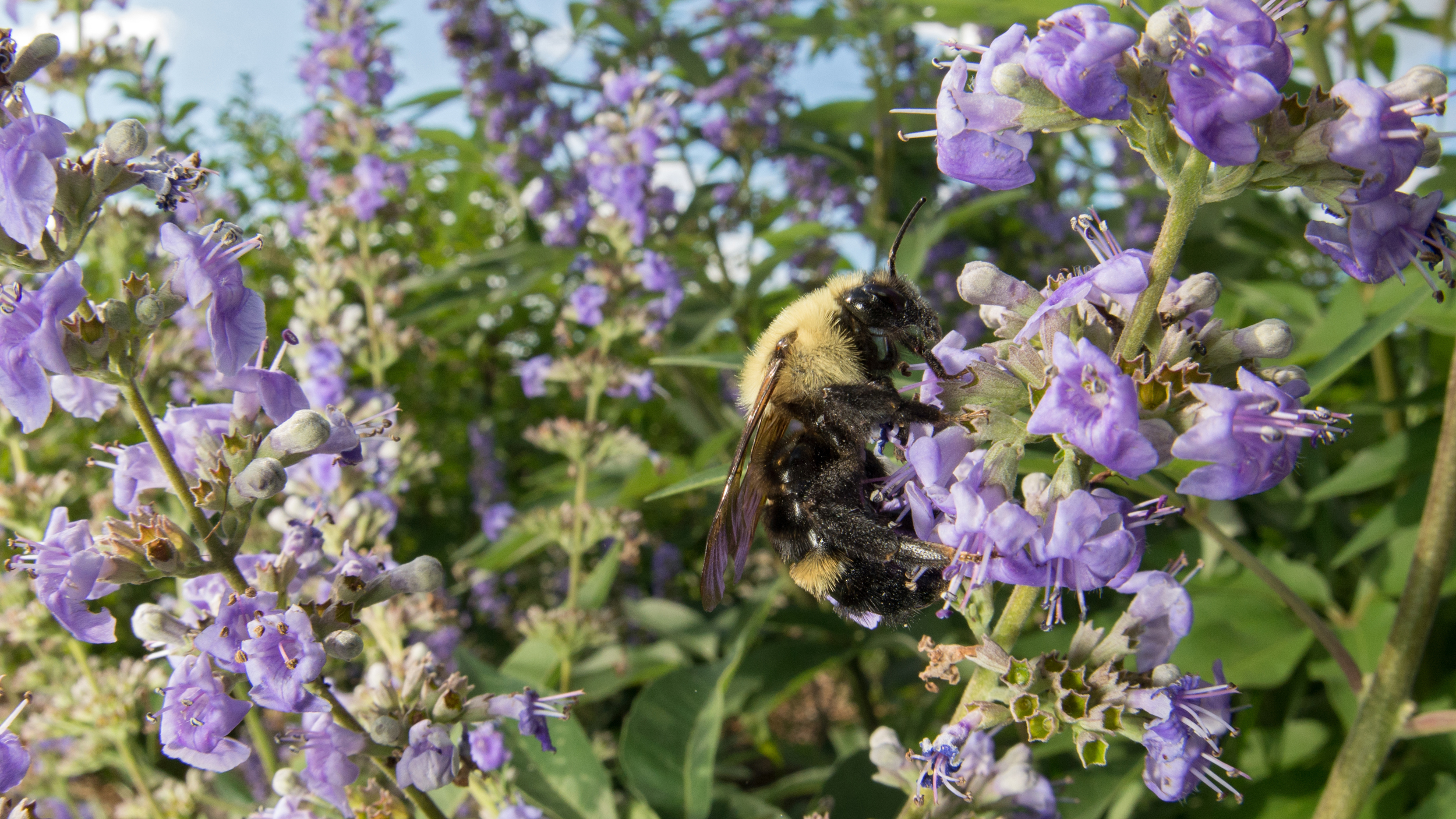
Six of the continent’s bumble bee species are cowbird-like brood parasites; queens lay eggs in nests of other bumble bees and let the workers rear their young.
Honey bees are far from the main threat to bumble bees; but they compete with them thus reducing their reproduction and body size. And while both honey bees and bumble bees are important pollinators, bumble bees are frequently more efficient. Unlike honey bees, they can “buzz pollinate,” seizing a flower in their jaws and forelegs and vibrating their wing muscles to shake pollen from the anther. This ability makes bumble bees important for pollinating a wide variety of wild and cultivated plants. Bumble bees help sustain all manner of things prized by humans from tomatoes to grizzly bears.
The wildlife management establishment has traditionally ignored native bees. But that’s starting to change thanks to bee advocates led by the Xerces Society, Clay Bolt, Dr. Sydney Cameron of the University of Illinois and Dr. Robbin Thorp of the University of California at Davis.
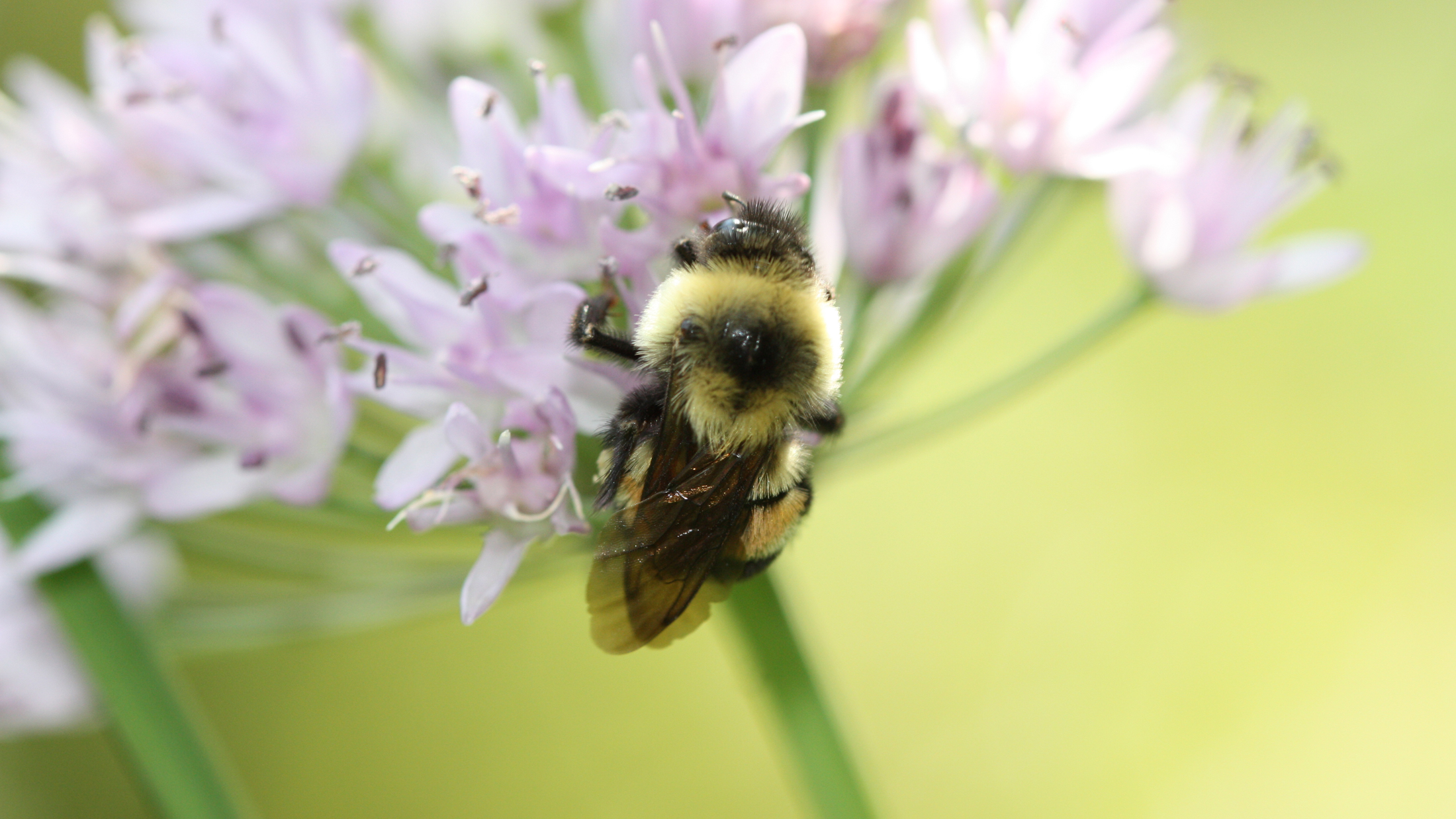
On March 22, 2017 the rusty patched bumble bee became the first bee in the continental U.S. to be listed as endangered by the U.S. Fish and Wildlife Service. The publicity is awakening managers and the public to the importance of native bees. In addition to sustaining native ecosystems they provide pollination services to American farmers worth $9 billion per year. “The listing of the rusty patched bumble bee has the potential to become a landmark case for pollinator protection,” remarks Bolt.
Rousting the feds to action was a challenge. The process started in 2010 when the Xerces Society, the Natural Resources Defense Council, Defenders of Wildlife and Thorp, alarmed about the rapid spread of bee diseases and parasites, petitioned the Animal and Plant Health Inspection Service (APHIS) to regulate interstate transport of bumble bees commercially bred for greenhouse pollination. APHIS didn’t respond for almost four years, then declined to do anything significant.
In 2013 the Xerces Society petitioned the Fish and Wildlife Service to list the rusty patched bumble bee as endangered. By law the agency has 90 days to decide if a petition for listing has merit. Nine hundred days later it hadn’t made a decision. Eventually a Xerces lawsuit elicited action.
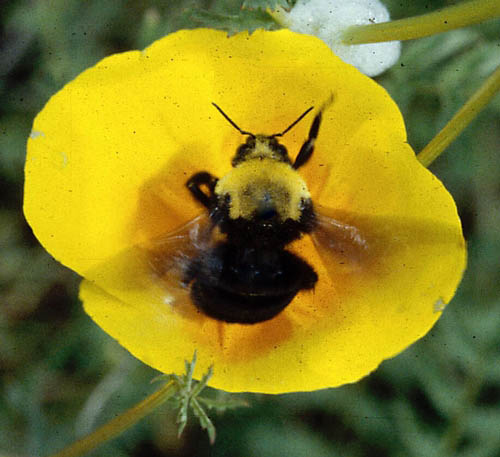
Interstate commerce of the eastern bumble bee is still essentially unregulated; and it has apparently imperiled American, yellow-banded, western and rusty patched bumble bees and caused the probable extinction of the Franklin’s bumble bee which hasn’t been seen since Thorp observed it in 2006. All five species were common 20 years ago.
At least APHIS forbids importation of bees from other nations except Canada, but between 1992 and 1994 it permitted western and eastern bumble bee queens to be shipped to Europe for rearing and their colonies to be distributed throughout North America. While the bumble bee fungal disease Nosema bombi is apparently native to North America, Thorp hypothesizes that a more virulent strain was introduced by the foreign-bred colonies. But Dr. Sydney Cameron could find virtually no observable difference between native and European Nosema. She suggests that commercial colonies might have had higher prevalence of Nosema, which spread to wild populations.
In any case, the sudden demise of the five common bumble bees — which, save for the American bumble bee, are closely related — corresponds precisely with bumble-bee commercialization in North America. I asked Thorp if pesticides, known to devastate bees, might have been partly responsible. “That doesn’t make sense,” he said, “because other bumble bee species in the same areas are doing well.” Of course, pesticides could weaken more vulnerable species, enhancing risks of infection. Cameron’s lab is investigating that potential.
In addition to Nosema, commercial bumble bee colonies in the U.S. have repeatedly been found to carry such wild-bee-afflicting parasites and pathogens as external mites, gut mites, gut protozoa, deformed-wing virus, black queen cell virus, sac brood virus and Israeli acute paralysis virus.

Every year in nations around the world millions of commercially produced bumble bee colonies are imported to pollinate greenhouse plants. They easily escape. In Argentina and Chile buff-tailed bumble bees imported from Europe are driving the beautiful, orange-furred flying mouse, the world’s largest bumble bee, toward extinction. Wherever the alien shows up the native vanishes.
Pesticides, especially neonicotinoids, are doing a number on native bees and honey bees. In the 1990s chemical companies, under pressure to develop safer pesticides for birds and mammals, hatched poisons that could be applied to seeds. These neonicotinoids were indeed less toxic to birds and mammals, but because they’re water soluble and absorbed into pollen they’re deadly for bees and other pollinators. They’re the default pesticide for soybeans and corn, yet research has shown them to be ineffective. One three-year study revealed zero corn yield benefit from neonicotinoid seed treatments. Similar results have been seen for soy.
Europe has sharply limited neonicotinoid use, and Canada is in the process of doing so. But our Environmental Protection Agency has yet to act. Last May the U.S. District Court for Northern California ruled that the agency had violated the Endangered Species Act by not adequately reviewing 59 neonicotinoid registrations.
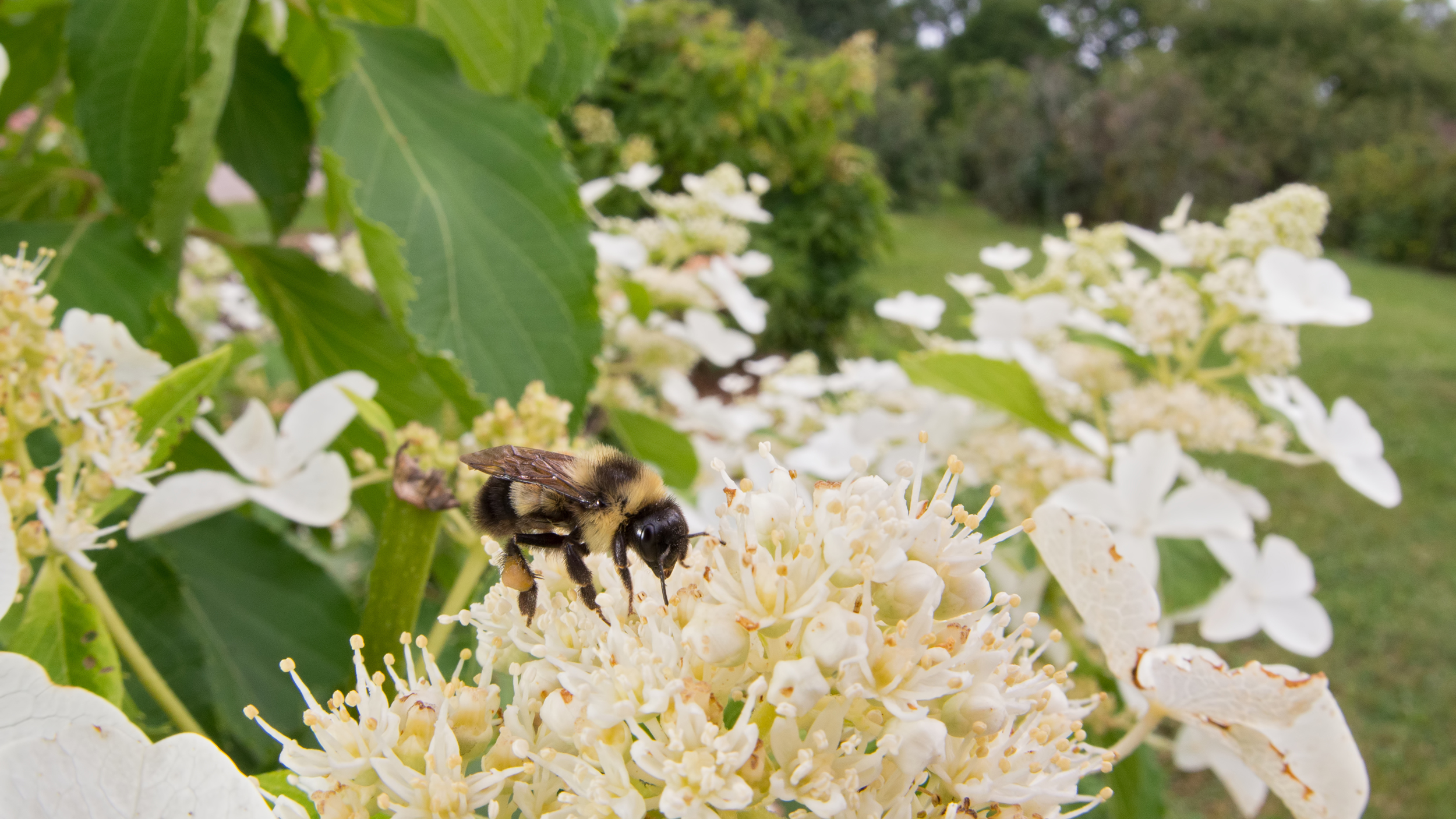
While the EPA has recently published preliminary pollinator-only risk assessments for three neonicotinoids and will be collecting public comments until July 24, the regulation process is slow. Critiquing that process, Aimee Code, who directs the pesticide program for the Xerces Society, notes that EPA gets its information from the companies that make the pesticides. “We’re not expecting final decisions for another couple years,” she says. “And EPA’s assessments are focused on only honey bees and thus fail to protect the more sensitive bumble bees. While a honey bee queen doesn’t forage, the bumble bee queen does, putting her at risk of pesticide exposure. If the queen is killed, the colony is lost.”
On June 23 a bill to better regulate neonicotinoid use — Saving America’s Pollinators Act of 2017 — was introduced in the House by 30 cosponsors.
While the feds aren’t doing much to recover native bees, there’s a great deal the public can do. Native bees need only three things — flowers, nesting sites and a pesticide-free environment. Provide these, and they will come.
How You Can Help Native Bees
To learn what to plant for native bees check out the Xerces Society’s Pollinator Resource Center.

You destroy bumble-bee nests sites by mowing, so let part of your yard go back to nature. When you do mow leave lawn clippings in an out-of-the-way pile; some bumble bee species will nest there.
If you want predator insects like lacewings, assassin bugs, garden spiders and praying mantises, you have to have a few pests for them to eat. But major pest infestations are symptoms of greater problems such as poor soil, wrong pH, too much or too little water or sun. Fix these, and you won’t need pesticides.
“Urban areas can provide amazing habitat for our native bees,” says Code. “You should never feel your own backyard isn’t enough. Urban areas have great diversity which can be better than a monocrop with, say, miles of corn.”
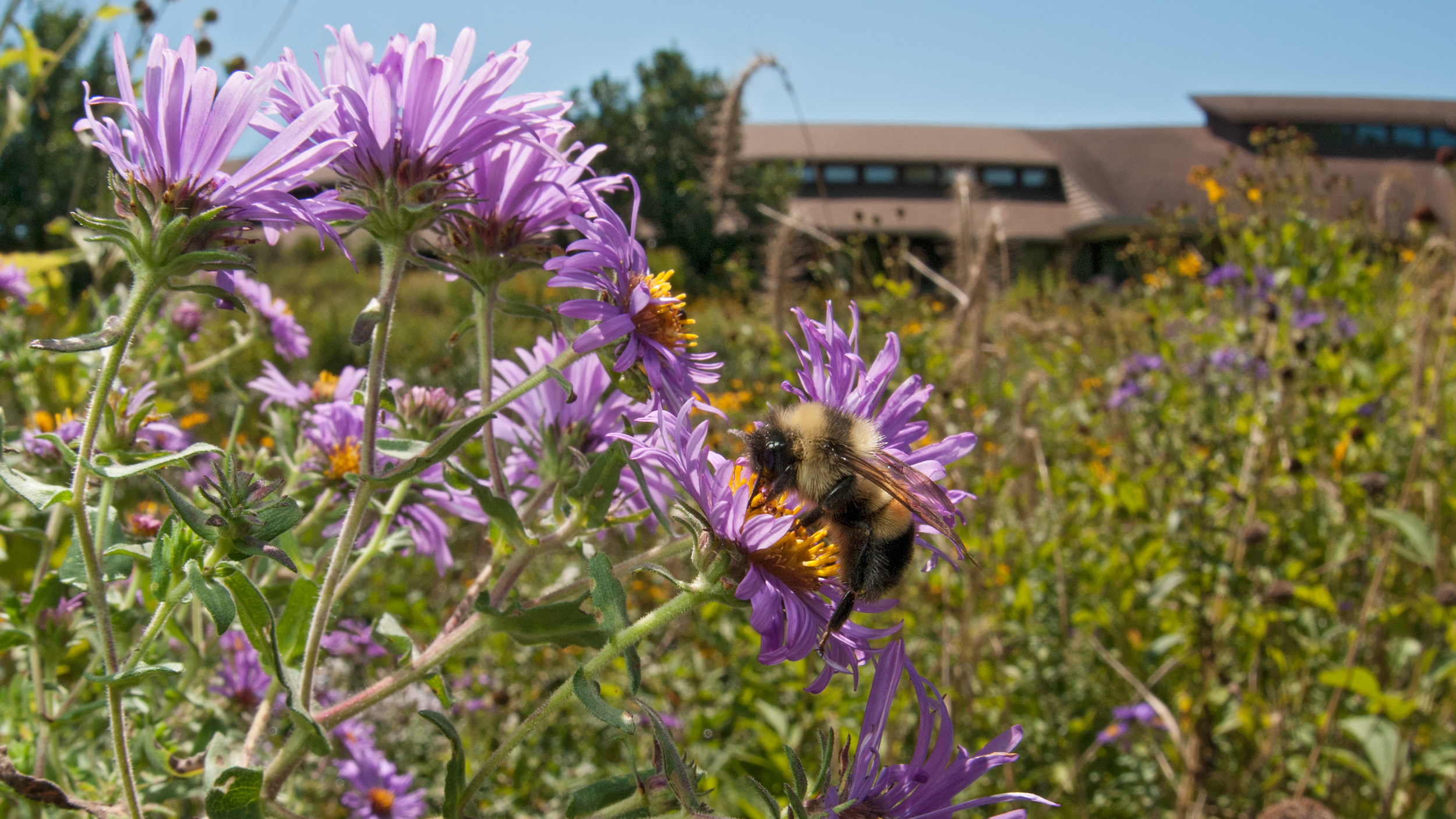
Learn to identify bumble bees by: 1. ordering Bumble Bees of North America: An Identification Guide, by Paul Williams, Robbin Thorp, Leif Richardson and Sheila Colla, 2014. Princeton, University Press; 2. downloading this online field guide and this one from Bee Spotter and 3. downloading these flashcards.
Participate in these citizen-science projects: Bumble Bee Watch and BeeSpotter.
Take the Pollinator Protection Pledge.
Finally, download Clay Bolt’s superb film A Ghost in the Making — about his successful search for and advocacy of the rusty patched bumble bee.
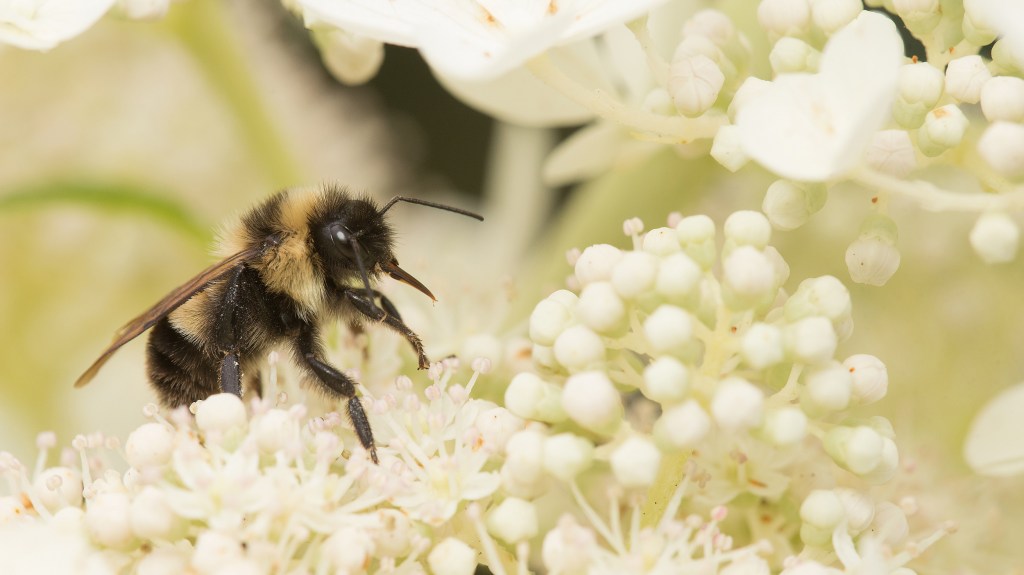



Thank you so very much for your field work, all your efforts! I appreciated the info. on what I personally can do for my bee friends. I am a backyard gardener, and know how the bee’s work in the system of plants & vegetables. Again thank you for bringing this info. to the public’s attention.
When we were in London in June, we had the opportunity to see St Ermin’s Hotel’s wonderful bee garden on a screened outdoor balcony. The bees there produced all the honey used by the hotel and restaurant as well as honey for sale. It seemed strange to see this in the middle of the city and then to find that other businesses were doing similar projects until I looked around and realised the amazing amount of flowering plants and grasses decorating businesses and streets as well as all the enormous public and royal gardens! Why can’t we do this too?
Does the spraying of permithrin to kill ticks, also kill bees?
Thank you for the informative film and pictures of the bumblebee. I had no idea there were so many species. I have a blue flowering bush that has bumblebees all over it. I don’t know the name of the bush but the bees love it. Before seeing this, I thought I had some weird bees on there. After watching the film, I realize I have at least 4 different types of bumblebees. One even has a rusty red patch. I know it’s not the one you were looking for since I’m in northern Nevada. Still interesting to note the different colors on the bees. Thank you again for your effort.
“Honey bees don’t belong in North America; they’re domesticated aliens from Europe. “Worrying about their extinction is like worrying about the extinction of cattle,” declares native-bee activist and acclaimed wildlife photographer Clay Bolt.”
Bolt is nuts. Honey bees are indeed aliens but certainly not to be included with cattle. The aliens most destructive of habitat are Homo sapiens sapiens. H.sapiens around here (south-central Iowa ) uses a multitude of chemicals on crops which have all but eliminated both bees and pollinating wasps. Our yard is hymenoptera friendly, but seeing a honey bee means that other bees are doing better.
Great article. Enjoyed reading it as it was very informative.
My husband and I just moved to our own home across town in central east coast Florida. I had many flowering herbs and trees, but the bumblebees(not many honey bees) liked the Vitex flowers the best. I had never seen so many bumble bees in one place before. I wish that I could have taken them with me..I haven’t seen any at our new place, though I hope that the organic farmette we moved there does eventually attract them and I will follow your suggestions in setting aside a wild area and encouraging nesting areas and, of course, lots of Vitex!
What I don’t understand is that a neighbor across the street would have a tank of pesticides sprayed all over his outdoor areas and yard (Tru Green)monthly, and occasionally the wind would blow our way. Yet it did not seem to diminish the numbers or visits from my bumblebee friends. How do you account for that? Is it possible that, being wild and probably genetically more pure, that they still have the ability to adapt to such harsh environments? Any thoughts?
My frustration is how little most people know. My big issue and growing frustration is the obsession with mowing in our country. I see huge expenses of lawns and areas not even near homes mowed for hours all summer long. Our local Environmental group is trying to convince our township, with success, to reduce mowing in the township. But you always get some homeowner call so upset with the unkept look! We are looking to address our County this winter with doing away with some of the mowing along certain roads, especially where we notice milkweed growing, which they just mowed down a week ago. Along with this is increasing areas to allow natural meadows for pollinators. Any feedback on how to properly present these issues to our County?
If it makes Ted feel any better – the cone flowers in our garden are covered with bumble bees (specific variety unknown to me). We see almost no domestic honey bees. We live in a suburban/rural county east of Cleveland, Ohio.
I am so glad that the Bees are back, so glad to stay for good.